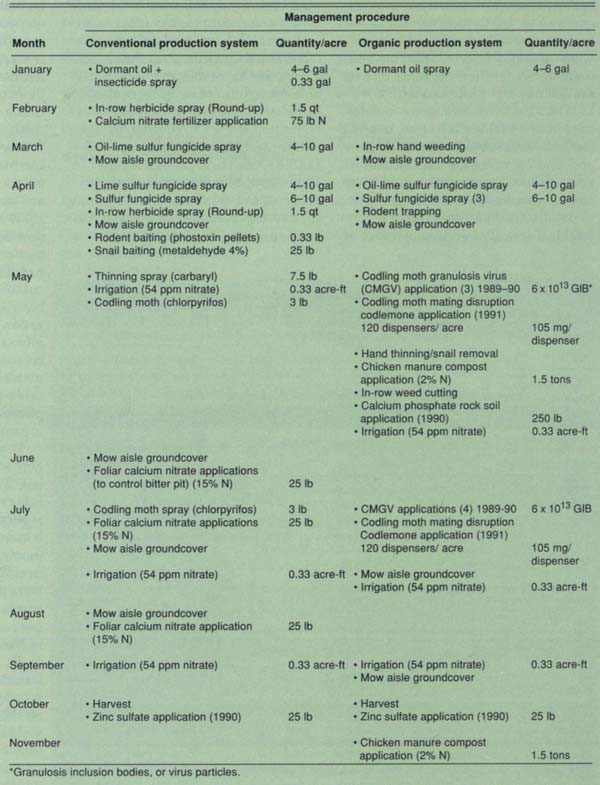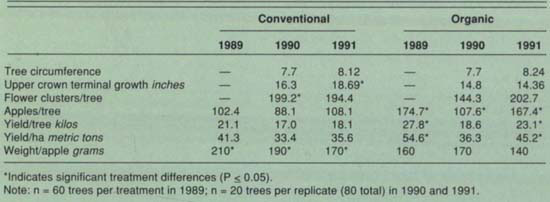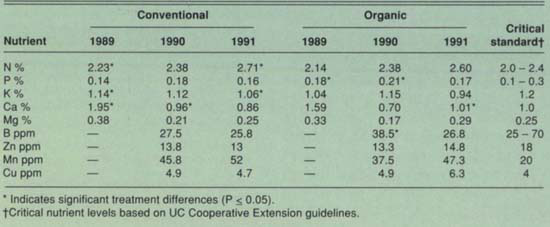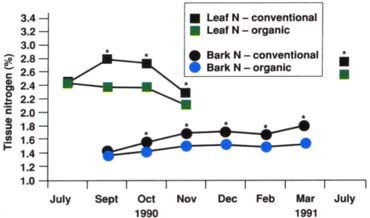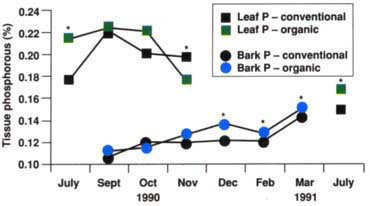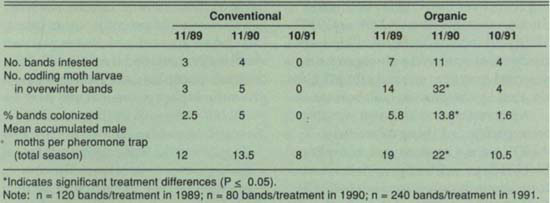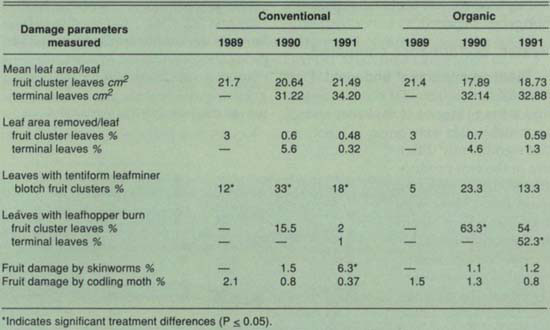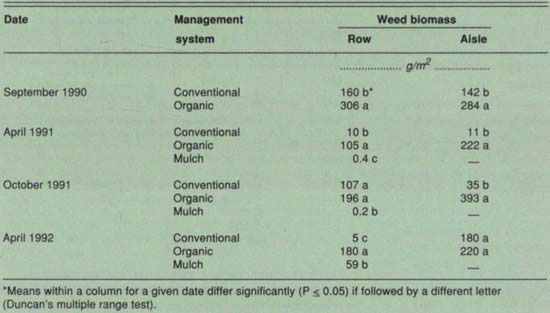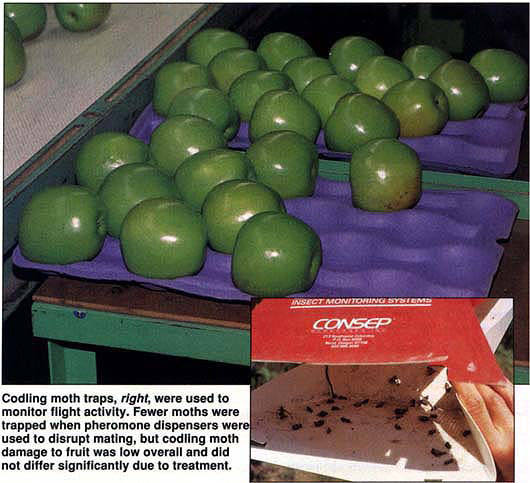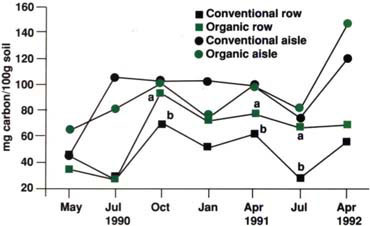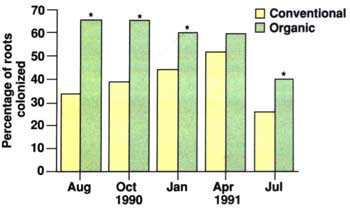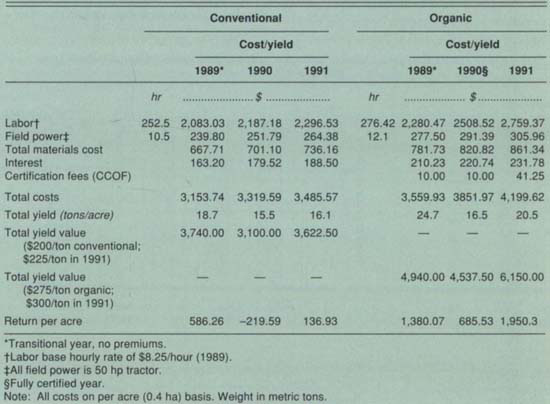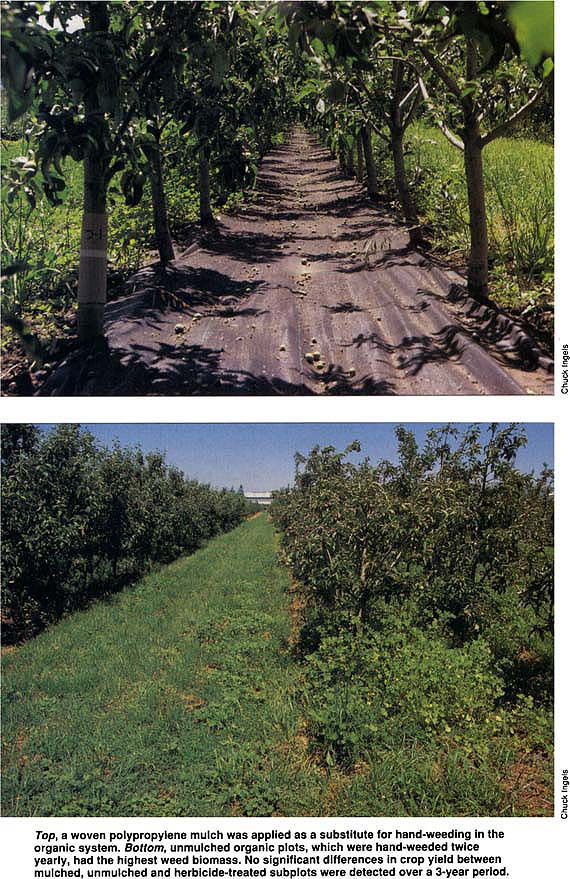All Issues
In Santa Cruz County, Granny Smith conversions to organic show early success
Publication Information
California Agriculture 48(6):36-44.
Published November 01, 1994
PDF | Citation | Permissions
Abstract
Conventional and organic semidwarf Granny Smith apple production systems were compared during 3 years of conversion to certified organic management on California's Central Coast. Yields were significantly higher in the organic production system in 1989 and 1991 due to significantly greater fruit load. Growth indicators such as tree girth, terminal growth, leaf area, and so on, did not generally differ, but tissue levels of nitrogen were generally higher in leaf and new wood bark tissue in the conventional system, while phosphorus levels were generally higher in tissue of the wganically managed trees. Key sconomic pest damage did not differ significantly in any year, although fruit and leaf damage due to some lepidopterous secondary uests was greater in some years in the conventional system. Apple kaf hoppers showed significant hcreases in leaf damage in the organic system. Price premiums for wganic apples consistently proiuced higher per-acre return for this system.
Full text
Making up a small but growing percentage of statewide acreage, certified organic apple production represents a potential alternative for California's conventional growers. Of over 30,000 acres used to cultivate apples in the state, between 1,500 and 2,000 acres are organic and in a certification program, according to growers' lists kept by California Certified Organic Farmers (CCOF), a major certification organization. This acreage has more than tripled since 1987, when fewer than 500 acres were certified statewide. In Santa Cruz County over 600 acres of apples are certified or in transition to organic certification. This increase in organic conversion rests heavily on the expanding market for certified organic apples for both fresh market and processing fruit.
Although conventional apple production systems in California are technically well documented, there is a nearly complete lack of published research on alternative management for the certified organic market, as presently defined by the California Organic Foods Act of 1990. Despite the increased interest in organic production, there has been little research on the agronomic and economic changes that occur during the conversion to organic management. We began to study this conversion process in April 1989, establishing blocks of conventionally and organically managed production systems in a commercial semidwarf Granny Smith apple planting. The study site was located in an established conventional apple orchard east of Watsonville. In 1990 the UC Sustainable Agriculture Research and Education Program joined with the UC Santa Cruz Center for Agroecology and Sustainable Food Systems (formerly the Agroecology Program) to fund an on-farm, grower-managed study of the 3-year transition to certified organic apple production at this site.
Our objective was to compare an organic production system during and after conversion to certified organic management with the conventional production system. Our plan included the monitoring of potential yield-limiting factors, such as soil characteristics, nutrient availability and pest abundance and impact. Using the systems-level approach to conversion studies developed previously (California Agriculture, July-August 1990), we evaluated the ecological and economic sustainability of certified organic apple production on the Central California coast. The following report reflects the first 3 years of our proposed 10-year study.
Monitoring treatments
Both organic and conventional treatments consisted of four 0.4-hectare replicates of semidwarf (M 106) seven-leaf Granny Smith trees planted in double rows. Within the 7.3-hectare, high-density (807 trees per acre) site, each replicate consisted of six double rows (54 trees per row) with a tractor aisle distance of 4.3 m between rows and a distance of 1.8 m between trees. Each double row was 1.2 m wide. A tractor aisle with a mowed grass cover (largely composed of rescuegrass, Bromus willdenowii) was maintained between the double rows.
The first year of transition was 1989, and organic certification was obtained for the 1990 and 1991 crop seasons. (Before 1991, CCOF required 1 year of transition). All plots were irrigated with 0.33 acre-feet of well water from ground sprinklers three times, for a total of 1 acre-foot during the growing season. Nitrogen amendments were added to both production systems to increase fruit size, terminal growth and fruit color. Within the organic production system the main nitrogen source was chicken manure compost, which was applied with a spreader. Table 1 summarizes the production system treatments implemented by the grower-cooperator each year.
The baseline number of fruit buds per replicate was assumed to be similar at the beginning of the conversion study, as all replicates had received the conventional treatments since 1982. Plant development and yields were evaluated based on 20 randomly selected permanent sample trees per replicate. At full bloom, total flower and leaf clusters were counted; and at harvest, average terminal leaf area, diameter and length were measured. At harvest, five fully developed leaves were randomly selected from the midpoint of five terminal branches on each sample tree and processed with a LICOR 3050A leaf-area meter to determine individual surface areas; missing leaf area (measured by pen tracings and fill-in of missing tissue on clear acetate sheets) was estimated with the leaf area meter, to determine area lost to defoliators and disease relative to total leaf area. Trunk circumference of sample trees was measured at 30 cm from the soil surface. The length of five terminal branches was also measured. All fruit from the sample trees were removed, counted and weighed to determine yield.
Plant nutrient concentrations were determined by sampling 20 trees from each replicate on seven dates (1990–1991). Ten leaves were collected from two terminal shoots per tree, and each shoot was collected as representative of new season's wood; a single sample of old wood was collected at the same time. Pooled samples from each replicate were analyzed for total nitrogen (N) and phosphorus (P) at the UCSC Center for Agroecology and Sustainable Agriculture. Leaves were also sampled in late July of each year and submitted to the UC Division of Agriculture and Natural Resources (UCDANR) Analytical Laboratory in Davis for macro- and micronutrient analysis. In 1990 this latter analysis indicated that both the organic and conventional systems were below the critical standard for required zinc. Zinc amendments were added to both production systems in October 1990.
TABLE 3. Annual (late July) leaf nutrient analysis, apple conversion study, Watsonville, CA, 1989–1991
Soil characteristics were evaluated based on pooled soil samples collected at 3-month intervals from 0 to 10 cm depth in the tree rows of each plot. Air-dried ground samples were analyzed by the UC-DANR Analytical Laboratory. Soil pH, macronutrients (N, P, K, Ca, Mg and S) and micronutrients (Fe, Mn, Cu, Zn and B) were measured from these samples. Soil microbial biomass was evaluated based on pooled samples collected in the same manner at 3-month intervals from April 1990 to July 1991, and on a final sample collected in April 1992. Biomass was estimated using a modification of the fumigation-incubation method.
Levels of vesicular-arbuscular mycorrhizal (VAM) fungi were measured on pooled tree root samples collected at 3-month intervals (July 1990 to July 1991) by digging to 25 cm at eight random spots within the tree rows of each plot and gathering upturned roots by hand. Fine, cleaned lateral roots were cut to 1-cm lengths, then cleared, bleached and stained. Percent colonization by mycorrhizal fungi was determined microscopically. Because the increased presence of mycorrhizal fungi within the organic system might indicate a potential deficiency in soil phosphorus, a P amendment was added to organic replicates in May 1990.
To monitor codling moth flight, one new 10-mg codlemone (pheromone) lure was placed in a sticky wing trap hung on a tree in the middle of each replicate (60-day intervals), and trap bottoms were replaced as needed. To monitor codling moth pupation and overwintering, cardboard tree bands were placed 30 cm above the soil on trunks of 60 randomly selected trees per replicate in August and collected in November. Each season codling moth, fruit pest and disease agent infestation rates were determined by scoring visual fruit damage at harvest on the 20 permanent, whole-tree fruit yield samples. Within the conventional system, pest monitoring and control approaches were based on guidelines established by the state-wide UC IPM Project in the publication Integrated Pest Management for Apples and Pears. Apple leafhopper abundance was estimated visually at five randomly selected branches (1989, 1990) on 20 trees per treatment replicate, and by five beat-tray samples at fruit clusters and terminals of six randomly selected trees per replicate (1991). Terminal and fruit leaf samples were evaluated visually for European red mite, tentiform leaf miner blotch, apple leafhopper feeding damage or “burn,” powdery mildew and apple scab lesions at harvest. In 1991 a standard weather shelter with a hygrothermograph was established to monitor orchard temperatures. The statewide UC IPM IMPACT computer network was used to run the degree-day model for codling moth at the study site for timing of codling moth treatments.
Weed species and biomass were evaluated biannually to assess growth of winter (rain-fed) and summer (irrigated) weeds. Samples were collected from four 0.5-m2 quadrants between the double tree rows and four quadrants extending out from the trunk into the tractor aisle. Prior to 1989 all tree rows had been kept weed-free by chemical and physical treatments. In May 1989 a woven polypropylene mulch (Dewitt Pro-5 weed barrier, 136 g/m2) was applied to four complete tree rows in two organic production system replicates, while four adjacent tree rows were maintained unmulched. The effect of this mulch on weed biomass, tree growth and yield was assessed beginning in 1991. The mulch was used within the organic system to assess its potential as a substitute for hand weeding in the organic system. Due to the small area treated, the cost of this mulch ($250 per planted acre material cost) was not included in the overall economic comparison of the two systems.
We compared labor and materials costs in the two systems based on management records and costs provided by the grower-collaborator in a postharvest interview. Baseline operating budget calculations for the first production year comparison were based on estimates by UC Cooperative Extension in Santa Cruz County and reviewed by the grower-collaborator. Because the production systems' treatments did not vary significantly during the 3-year study, we added a 5% annual inflationary increase in operating costs over baseline for both production systems during 1990 and 1991. Yield and income were calculated directly from observed values, and the seasonal average tonnage sale price estimated by the grower-collaborator.
All comparisons between variables were performed using a two-way ANOVA for a randomized, complete block design, with appropriate transformations of non-normal data. Statistical significance was determined at P < 0.05 for all comparisons between production systems, using Duncan's multiple range test for mean separation when required.
System performance compared
Plant development and yield
Tree circumference, terminal shoot growth and average area of fruit cluster and terminal leaves were not significantly different in the two production systems, with two exceptions: There was a greater return bloom in the conventional system in 1990, and terminal growth was greater in the conventional system in 1991 (table 2). Yields per tree were significantly higher in the organic production system in 1989 and 1991 due to larger fruit number per tree each year. This higher fruit load was a result of hand-thinning, which left a greater number of apples on the trees. Although the average weight of apples in the conventional system was significantly greater in all years, the overall apple tonnage was greater in the organic system due to significantly larger fruit numbers.
Plant nutrient status
The annual leaf and new wood bark nutrient analyses showed that significant differences in nutrient concentrations existed between production systems (table 3). Total concentrations of nitrogen (N) were consistently higher in leaf and new wood bark tissue of conventionally managed trees (fig. 1). In contrast, phosphorus (P) levels were generally higher in the leaf and new wood bark tissue of the organically managed trees (fig. 2).
Potassium (K) leaf concentrations were significantly greater in the conventional production system in both the July 1989 and July 1991 samples (table 3). Calcium (Ca) leaf concentrations were significantly greater in the conventional system in both the July 1989 and July 1990 samples due to foliar calcium nitrate applications in this production system. In contrast, Ca concentrations were significantly greater in the organic production system in the July 1991 sample.
Fig. 1. Fluctuations of nitrogen concentration in leaf and new wood bark over seven sample dates, 1990–1991.
Fig. 2. Fluctuations of phosphorus concentration in leaf and new wood bark over seven sample dates, 1990–1991.
TABLE 5. Insect-caused defoliation and fruit damage, apple conversion study, Watsonville, CA, 1989–1991
Soil nutrient levels and microbial biomass
Soil nutrient levels (other than K at the experiment's onset) showed no significant differences during the course of the study. Microbial biomass was significantly greater on three sample dates in organic production system tree rows and lower in conventional production system tree rows (fig. 3).
VAM fungi
Vesicular-arbuscular mycorrhizal (VAM) colonization was consistently higher on apple roots in the organic production system. Statistically significant differences were detected on all sample dates except April 1991 (fig. 4).
Key pest abundance
The production systems were consistently subject to two generations (reflected in two male flight peaks) of codling moth, with the first peak of males captured (April) representing the emergence of the overwintering generation, and the second peak (July) representing the first generation. In 1991 there was general agreement of male flight periods with computer model predictions, which allowed more accurate timing of pheromone-based mating disruption treatments to correspond with adult emergence and flight. Significantly higher numbers of codling moths accumulated in codling moth traps and tree bands in the organic, codling moth granulosis virus-treated (CMGV) production system in 1990 but not in 1991, when codlemone (pheromone) dispensers were used to disrupt mating (table 4).
Codling moth damage to harvestable fruit did not differ significantly due to production system treatment (table 5). In 1991, however, significantly greater skinworm feeding damage (by orange tortrix, Argyrotaenia citrana, and apple pandemis, Pandemis pyrusana) was detected in the conventional production system. A higher percentage of tentiform leaf miner (Phyllonorycter spp.) blotches was found in the conventional production system in all years. No significant differences in defoliator damage were detected in any year. White apple leafhopper (Typhlocyba pomaria) burn was significantly greater in the organic production system in 1990 and 1991. Weekly white apple leafhopper populations were consistently higher in the organic production system during the 3 observed years. Other homopterous pests, such as aphids, occurred only sporadically during the spring in each growing season. Low, subeconomic densities of European red mite, powdery mildew, and apple scab were encountered on leaf samples at harvest in both production systems, but no significant differences were detected at these low levels.
Weed species and biomass
In the area between the double tree rows, unmulched organic plots (subject to twice-yearly winter and spring hand-weeding) had the highest weed biomass on all sample dates (table 6). In the trunk area outward toward the middle of the aisle, the organic production system had greater weed biomass until April 1992, when there was no significant difference between treatments. This difference was due to the difficulty of close-mowing all of this trunk area without damaging the trees in the organic production system. No significant differences in crop yield between mulched, unmulched and herbicide-treated subplots could be detected over a 3-year period.
Codling moth traps, right, were used to monitor flight activity. Fewer moths were trapped when pheromone dispensers were used to disrupt mating, but codling moth damage to fruit was low overall and did not differ significantly due to treatment.
Costs and income
Comparative cost-accounting for the transition year (1989) and the first 2 certified organic production seasons (1990 and 1991) indicates that the organic production system used 10% more labor and had a 17% higher materials cost (table 7). Return per acre was higher in transitional organic production due to higher yield of smaller apples from this lightly hand-thinned production system in 1989. In 1990 and 1991 the certified organic production systems showed higher net profits when compared with the conventional production system, due to higher yield and an estimated $75 per ton premium when sold on the organic market.
Early success of conversion
The 3-year conversion study results show that yield of apples and tree growth indicators of apple trees were not adversely affected by certified organic management practices. This is the first production system comparison of this type in California's Central Coast apple production region, and it is noteworthy for the early relative success of conversion to certified organic practices in a fresh market production system.
Fig. 3. Soil microbial biomass in surface 0 to 10 cm, Watsonville, CA, 1990–1992. If followed by a different letter, values for a given date differ significantly (P ≤ 0.05).
Due to the lack of chemical thinning agents approved for use in certified organic production in California, hand-thinning is a major labor expense of the organic production system. Although attempts were made to equalize the number of apples left on trees in both production systems, consistency within the hand- and chemical-thinning processes themselves proved to be difficult to attain. Hand-thinning consistently left a greater number of apples on the organic trees and contributed to the larger total yields in the organic system. It was found that increased fruit load in the organic production system affected return bloom in 1990, but this did not significantly affect subsequent yield in 1990. To better understand the relationship between apple tree yields, mean apple weight, and nutritional requirements of trees in both the organic and conventional systems, further studies must be conducted in which thinning regimes are standardized.
The generally lower nitrogen content of leaf and new wood bark tissue in the organic production system trees may be due to a greater demand on nitrogen reserves, possibly placed on the system by its higher fruit production. In the absence of differences in soil fertility, and assuming similar nitrogen content in fruit, higher fruit load seems likely to create a greater demand on nitrogen reserves in the organic production system.
The addition of calcium phosphate rock to the organic system in May 1990 makes the organic tissue's higher phosphorus content difficult to interpret. Assuming that the phosphorus content of fruit is similar in both production systems, a greater demand in the organic trees would be expected due to increased fruit load. This higher phosphorus demand may be masked by the fact that more phosphorus was available to the organic system. Organic leaf and new bark tissues had higher phosphorus concentrations when the nutrient comparisons began. By the end of the 1990 harvest in November, however, phosphorus content was significantly lower in the leaf tissues of the organic system. The greater VA-mycorrhizal fungi colonization in the organic production system is potentially important, as it has been found to increase the uptake of phosphorus by apple tree roots. These symbionts may provide organic orchards with a greater accessibility to soil phosphorus.
TABLE 7. Comparative apple production systems costs and yields, apple conversion study, Watsonville, CA, 1989–1991
Foliar calcium nitrate was applied annually to the conventional system for prevention of the fruit disorder bitter pit, probably accounting for higher leaf calcium in 1989 and 1990. Although amendments to counter bitter pit in organic systems are available, the grower-cooperator in our study had not had problems with bitter bit in the past and so did not add this preventive foliar amendment to the organic system. Although no bitter pit problems were seen in either system, our study showed that the addition of foliar calcium nitrate did significantly increase the amount of tissue calcium in the conventional system in 2 of the 3 monitored years. It is suggested that tissue concentrations of calcium be routinely monitored and that amendments be applied as needed.
Although potassium amendments were not added to either production system, potassium concentrations were significantly greater in the conventional leaf sample in 2 of the 3 monitored years. This is probably due to increased demands on potassium reserves by greater fruit loads in the organic production system. The grower-cooperator did not consider these deficiencies to be serious in this orchard. Potassium concentrations should be monitored in organic systems and amendments added to counter possible deficiencies, but with attention to possible effects on calcium uptake.
Microbial biomass can provide an early indicator of changes in soil organic-matter dynamics induced by management changes. Microbial biomass increased in the organic production tree rows. The soil biomass is an important source of and sink for nutrients, and this indicator has potential significance, especially in organic production systems where fertility is based on organic matter management.
A management program of CMGV and mating disruption pheromone dispenser applications in the organic production system (as well as insecticide applications in the conventional production system) resulted in low codling moth damage to fruit in both production systems. The absence of a second codling moth generation (coinciding with harvest of most apple varieties in the coastal production region) is characteristic of the cool, sea-level coastal valley climate in most years and offers a distinct bio-environmental advantage to these production sites. Foggy coastal evening conditions and rapid ambient temperature drops below flight temperature thresholds limit flights of codling moths in the Pajaro Valley floor area near Watsonville.
Increased leaf damage by tentiform leaf miner and decreased parasitism by a complex of hymenopterous parasitoids may be induced in the conventional production system by insecticide applications. A complex of parasitoids that is known to attack tentiform leaf miner in coastal California is disrupted by insecticidal sprays. We observed this effect in the conventional production system when compared with the synthetic insecticide stress-free organic production system. We postulate a similar mechanism for increased fruit scarring by orange tortrix and apple Pandemis in the conventional production system in 1991. The parasite or predator complex involved in the regulation of secondary lepidopterous pests in organic production systems should be identified and its contribution to overall mortality evaluated. However, white apple leafhopper abundance and leaf damage in the organic production system increased when compared with the conventional production system. The natural control factors involved in leafhopper abundance in organic production systems should be determined.
Top, a woven polypropylene mulch was applied as a substitute for hand-weeding in the organic system. Bottom, unmulched organic plots, which were hand-weeded twice yearly, had the highest weed biomass. No significant differences in crop yield between mulched, unmulched and herbicide-treated subplots were detected over a 3-year period.
Although weed growth was significantly greater in the organic production system, no decline in fruit yield was observed. This finding indicates that in the first 3 years vigorous semidwarf trees 7 to 9 years of age do not encounter yield-reducing competition from the weedy cover in the organic production system. However, the presence of this cover could lead to increased rodent damage. Timely winter and spring in-row weeding in a small area around the base of trees is required to limit potential for rodent damage. A polypropylene mulch effectively eliminated the need for this hand-weeding from 1989 to 1991. However, it is important to remove any weeds growing on top of this mulch before the roots penetrate the fabric. This weeding is relatively easy to perform before a root zone is established through and below the surface of the mulch.
In this conversion study, the M 106 rootstock had been planted in a freestanding, high-density, double-row system, and the desired cultivar, Granny Smith, was grafted to the root-stock. Typically, this system is brought into production in the second or third year following planting. In the Central Coast area, an organic production system planted in single rows would allow easier nonchemical weed control by mowing and tillage. Although plastic mulching could be more effective than mowing and tillage and is as efficient as herbicide use, its initial expense ($300 per acre material and application costs) and the lack of competition faced by apple trees from weeds may counter its advantages.
Certified organic production in 1990 and 1991 showed higher profits, due to increased tonnage and premium certified organic prices obtained by this fruit. The organic production system requires increased expenditure on labor when compared with the conventional system, due to hand-thinning and hand-weeding requirements. Higher materials costs in this system reflect microbial insecticide or pheromone dispenser applications and tractor time. A farm-gate price premium of 33 to 38% for organic apples accounts for a higher return per acre in the organic system. In fact, an over-supply of Granny Smith apples to the conventional marketplace has led to relatively low profits or negative net returns on conventional production system acreage that does not achieve a minimum of approximately 20 tons per acre yield in the coastal growing region. The future stability of premiums for organic fruit may also affect production decisions.
Many specific features of the Central Coast organic production system are unique; low codling moth and disease pressure due to cool temperatures and relatively dry spring weather are distinct climate-related advantages. Many established apple-growing areas in this production region are therefore environmentally well suited to become certified organic production systems for apples. Presently, approximately 15% of apple acreage in Santa Cruz County is certified organic.
Warmer and more moist production environments in the state may face increased pest pressure. However, the same principles of pest suppression and tree management are applicable. Higher and more frequently applied doses of codling moth mating disruptants can be integrated with orchard sanitation and supplemental applications of microbial insecticides or the release of trichogrammatid egg parasitoids. Disease suppression remains preventive with prophylactic sprays of inorganic compounds. Secondary pests can be expected, in most cases, to decrease in population density and damage, although increased monitoring of these pests is important. Orchard floor management will depend upon watering systems; mowing, cultivation and cover cropping techniques can be integrated. Nutrients for adequate tree growth can be supplied as soil-applied composts and minerals, foliar applications and green manures. All management options must be evaluated for their cost-effectiveness with respect to the market value of the apple variety to be produced in a certified organic production system.
Our long-term research objective is to continue this on-farm research and identify the ecological indicators of sustainability in the organic apple production system (pest population equilibria, nutrient cycling, energy use efficiency, faunal diversity, and so on) and relate these emergent properties meaningfully to tree growth and yield. We believe that this systems research model for apples is relevant for other production areas in California. An agroecological approach and whole-systems study model for organic apple management practices will be important for future production success.



